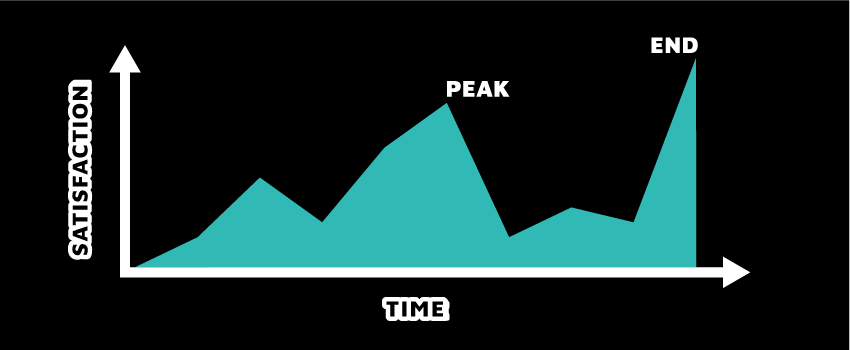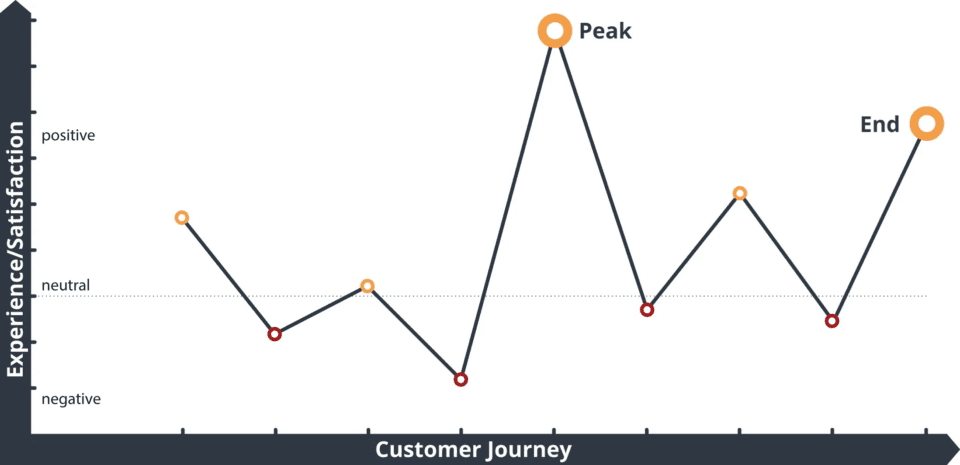Although each person’s memory capacity is different, they often have special operating rules. One of them is the Peak-end Rule – a memory rule that makes us tend to remember selectively based on the level of emotion. Therefore, the Peak-end Rule is also exploited by many brands such as Disney to change the level & attitude of customers remembering the brand.
Peak-end Rule of Motion
The Peak-end Rule was first proposed by Israeli psychologist and economist Daniel Kahneman and researcher Barbara Frederickson. Through a series of studies conducted in 1993, Kahneman and Frederickson found that people do not remember and evaluate an event based on the entire experience from that event, but they remember based on typical moments: The most intensely emotional moment & The moment the event ended.
The Peak-end Rule can be understood as a rule about human memory and perception. In it, we tend to simplify the process of remembering and evaluating an event or thing by focusing on the most prominent and typical memories and eliminating other experiences.
Among them, there are two moments that often have the greatest impact on people’s emotions and memories:
- The first is Peak: The moment that creates the most intense and powerful emotional climax, creating a deep impression in people’s memory.
- Second is End: The last moment of contact with that event or thing and also the most recent moment, not affected by any subsequent moment so it makes us remember it more easily.

Peak-end Rule is always present in every aspect of life. Sometimes, it motivates people to be optimistic, positive and remember better experiences. But there are also many cases where Peak-end Rule makes us become negative, pessimistic and sensitive. The following two examples will help you understand this psychology better: (Reference source: The Decision Lab).
Childbirth is a classic example of how the Peak-end Rule can reduce negative experiences and bring positive emotions to people. Most experiences during childbirth are quite painful for mothers, but the climax memory of the moment of birth and the feeling of finally holding the baby in their arms can significantly ease the process of childbirth.
In contrast, breakups are an example of the Peak-end Rule in action. No matter how good a relationship was during its entirety, we tend to think about the final moment — the breakup — which creates pain and other negative feelings when we think about our ex.
Why does Human Psychology form the Peak-end Rule?
Heuristic Representation Method
In their research, Dr. Daniel Kahneman and Dr. Barbara Fredrickson pointed out that the Peak-end Rule is considered a consequence of the heuristic representation search method. This is a psychological shortcut used to help people make quick decisions without having to search for too much information. The Heuristic method works based on comparing with available models in memory and mind to make judgments about a certain thing or event in front of us. From the habit of using this method, we will tend to remember an event by recording the images of outstanding, memorable moments from that event – Peak and End.
Emotional Bias in memory
Another simple reason is that we always have a better ability to remember events with stronger emotional intensity. Although there is no clear theory about this phenomenon, it has been proven in many different studies and surveys. That is why when we imagine an event or object, we will associate it with moments of the strongest and most intense emotions.
Prioritize Recent Memories
People tend to remember the beginning and end of a series of memories more than the memories near the middle. Because the memories in the middle often have continuity between memories, making it easy for us to confuse and difficult to remember. Meanwhile, the last memory is the end point of the series of memories, there is no agent behind it. At the same time, it is also the closest memory point to the human memory at the present time. Therefore, it is not difficult to explain why we tend to remember more deeply the last memory of a certain event or thing.
In general, human memory is limited, so it is obvious that we choose to remember the highlights.
The Impact of the Terminal Principle on Consumer Behavior
Similar to the two examples above, the Peak-end Rule also affects consumers’ memory and emotions when exposed to a Brand.
Change Consumer Sentiment about a Brand in both Positive and Negative ways
Even a small mistake along the customer journey, especially at the end of the journey, can change their perception of your brand. For example, you build a website with a smooth UI/UX design from start to finish. However, the final payment step is very cumbersome and requires customers to verify in a complicated way. This has ruined all your efforts in optimizing the customer experience in the previous steps, because they will only remember the final payment moment as difficult and unprofessional of the brand.
But on the contrary, if you know how to take advantage of this psychology, you can significantly improve customer sentiment without spending too much effort. Music festivals are one of the popular applications of this Peak-End Rule. When organizing a music festival for consumers, instead of trying to spread out too many activities during the night, focus on a special Keymoment. For example, a surprise, spectacular fireworks “party” on the background music of a vibrant song, creating an explosive climax moment for the audience. From there, forming a special, unforgettable memory in the eyes of consumers.
Influence on Product Price Perception
The Peak-End Rule has a huge impact on how consumers perceive the price of a product. Customers will always stick to the lowest price they have ever seen for your product and compare it to the last price they paid for a similar product to judge whether your product is expensive or not. That is why if you continuously sell large quantities at too high a discount, it can have a very negative impact on Sales in the long run. Because customers will remember that lowest price as the price they need to pay to get your product. When you sell it back to normal price, customers will feel that it is not the right price and they have bought it for a high price. Therefore, sometimes deep or excessive discounting strategies are a very risky move.
Reduce the Pain of Paying for Consumers
One of the biggest obstacles for consumers when buying is the pain of payment. Taking advantage of the Peak-end Rule psychology, creating positive and impressive final experiences is a very effective way to ease this pain. For example, after completing the payment process, you can give customers surprise gifts personalized according to their preferences. Such as exclusive vouchers, thank you letters written with the customer’s name in a meticulous and intimate way, … Or you can add thank you letters and small gifts to the package when shipping to consumers. For sensitive items, subtly cover the product name so that customers do not feel embarrassed when holding the final product. These small activities can create positive final memories about the brand and product to prevent losing customers.
Impact on Brand Content Consumption
This psychological rule also affects the way users consume content and messages from brands. They will not be able to remember all the content that you put on the media channels. Instead, they will start to look and grasp some prominent words, the last words in the text. So when presenting any message or article on the media channels, make sure you design the color or size, highlighting the most important words and content.
How do Brands apply the Peak-end Rule?
Disneyland and the Sweet Goodbye that Customers will never forget
One of the most important reasons for the attraction of Disneyland is the special moments that this amusement park has brought to visitors. When coming to Disneyland, you will see many photographers who are assigned to the park and are ready to take pictures for you to preserve the memories of the moments here. These photos have the task of remembering instead of the visitors’ brains when looking back at the photos, they will be reminded of special moments at Disneyland – something they may have unconsciously forgotten due to the limitations of human memory.

On the other hand, Disneyland also makes good use of the Peak-End Rule psychology by creating truly impressive final memories for each visitor to Disneyland. Before the park closes at 10 pm, Disney will broadcast the Disneyland Forever program at 9:00 pm combined with fireworks and vivid sound and visual effects along with the musical Storytelling “Kiss Goodnight”. This warm farewell has created a beautiful ending for each visitor’s visit to Disneyland. From there, it contributes to creating a beautiful memory of Disneyland in the minds of consumers.
Standard Life Changes Scenario According to Peak-End Rule, increases Satisfaction by 13%
Standard Life is an insurance company from the UK that has had a very effective strategy of changing the Customer Care scenario thanks to the application of the psychological law Peak-End Rule. Previously, the Customer Care calls of this brand took place according to a familiar scenario as follows.
- “Now that we have addressed your concerns, is there anything else I can help you with today?”
- Customer: “No”.
- “Would you like to take our survey about the quality of service you received?”
- Customer: “No”.
This is a fairly common scenario for many businesses today, but it inadvertently creates a not-so-good final memory of the brand. You can see that in both of the last two questions above, customers tend to give “no” answers – a rather negative answer and a color of annoyance from customers. This inadvertently creates a negative emotion at the end of the Customer Care journey and causes their satisfaction level to decrease.
Realizing this characteristic, the brand began to research and change the script type as follows:
“Have we answered all the questions you needed to today?”
Although the nature of the two questions is the same, consumers will tend to answer “yes” or “already” with this question. These two positive words will motivate them to respond to the next survey and create a more positive psychology for customers.
Reference: BeInside, The Decision Lab
Comment Policy: We truly value your comments and appreciate the time you take to share your thoughts and feedback with us.
Note: Comments that are identified as spam or purely promotional will be removed.
To enhance your commenting experience, consider creating a Gravatar account. By adding an avatar and using the same e-mail here, your comments will feature a unique and recognizable avatar, making it easier for other members to identify you.
Please use a valid e-mail address so you can receive notifications when your comments receive replies.
